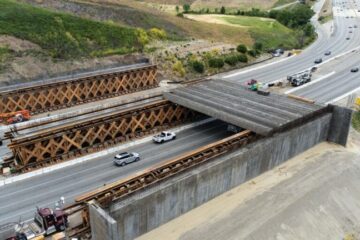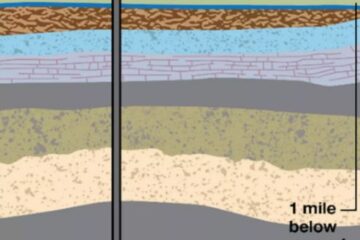Curbs on Dust in the West Targeted
The EPA wants to drop the clean-air rules for rural areas. An official with the air quality district for Owens Valley calls it ‘outrageous.’
Source of this article – Los Angeles Times, January 18, 2006
Bush administration officials are moving to strip significant clean-air protections from broad areas of California and other Western states, saying that rural areas should no longer have to meet federal rules for windblown clouds of dust, and that mining and farming operations also should be exempt.
The proposed rules were published in the Federal Register on Tuesday by the U.S. Environmental Protection Agency. They would become final later this year after a public comment period.
 In contrast to rural areas, the proposal would toughen rules on so-called coarse particulates in urban areas, including parts of Southern California. In Riverside and San Bernardino counties, dust from roads and construction sites has been a major contributor to smog. That part of the proposal has not been a subject of major controversy.
In contrast to rural areas, the proposal would toughen rules on so-called coarse particulates in urban areas, including parts of Southern California. In Riverside and San Bernardino counties, dust from roads and construction sites has been a major contributor to smog. That part of the proposal has not been a subject of major controversy.
The pullback in rural areas, which drew praise from the mining industry and condemnation from air regulators and environmentalists, would particularly affect places such as the Owens Valley, which has the worst dust storms in the nation — a product of Los Angeles’ draining of Owens Lake. The head of the regional air pollution control agency there called the administration’s proposal “outrageous.”
Although the rule would apply nationwide, its greatest impact would be in the Western states because the West has much larger rural areas and because dust is a greater concern in arid regions.
In a written statement to The Times, EPA spokesman John Millett said the new rule was based on “thorough consideration of thousands of studies of the health effects of particulate matter.”
“The evidence to date does not support a national air quality standard that would cover situations where most coarse particles in the air come from sources like windblown dust and soils, agricultural sources and mining sources.”
Millett said the EPA’s science advisory panel supported the policy. But the advisory commission’s report to EPA Administrator Stephen Johnson showed a difference of opinion among members.
Some said the EPA should continue to regulate dust in rural areas. And all panelists said the EPA should continue to monitor the level of particles. Under the proposal, the EPA would stop monitoring in rural areas.
California air pollution regulators disputed the EPA position.
 “They’re saying that what’s in windblown dust and soil, what’s being emitted from dirt, basically, is not bad for you. And we just don’t know that,” said Richard Bode, chief of the Health and Exposure Assessment Branch of the California Air Resources Board.
“They’re saying that what’s in windblown dust and soil, what’s being emitted from dirt, basically, is not bad for you. And we just don’t know that,” said Richard Bode, chief of the Health and Exposure Assessment Branch of the California Air Resources Board.
State air board officials said they were particularly concerned that the change in federal policy could harm air quality in the Owens Valley and three other parts of the state: the Salton Sea, where a water diversion program is set to begin that could create new air pollution headaches; northern Sacramento County; and the Calexico border region.
All four areas have levels of dust that sometimes violate current federal rules but would be exempt under the proposal because they are rural.
Under the plan, the EPA would continue to regulate so-called fine particulate matter — tiny particles from soot and other sources that can penetrate deep into the lungs. Those particles are closely tied to truck traffic and have become a major problem in Southern California.
In rural areas, regulation of coarse particles would fall to individual states. California is the only state with its own rule. And even in California, air regulators said, the absence of federal rules would weaken their ability to force industries to clean up.
“What EPA has done is unprecedented” by giving exemptions for certain parts of the country and certain industries, said William Becker, executive director of an association representing state and local air pollution control officials across the United States. Exempting farming and mining “ties the hands of most states,” he said.
Ted Schade, head of the Great Basin Unified Air Pollution Control District, which oversees air quality at Owens and Mono lakes, called the EPA proposal “a real slap in the face.”
Federal regulations have more teeth than state rules, carrying the possibility of fines for polluters and a loss of transportation funds for state governments if pollution levels are not brought down, Schade and state air regulators said.
The administration’s move “would take away that federal hammer,” Schade said.
Schade said that it was unfair to eliminate protections for more sparsely populated areas, and that federal regulators appeared to be ignoring visitors to four national parks and three wilderness areas that are sometimes hit by dust storms that start around Owens Lake.
He and others disputed the EPA’s contention that health studies have shown inconclusively that large-particle dust from mining or agriculture is dangerous. In some parts of the West, including the Owens Valley, the soil contains arsenic, sulfur compounds and toxic metals that can make dust clouds a potential health hazard.
Air regulators cited studies in the Coachella Valley and elsewhere that have shown that coarse dust can clog lungs and cause asthma, heart disease and other health problems. They said that although fewer studies had been done in rural areas than in urban regions, the lack of data should be a reason to maintain standards and continue studies, not eliminate the rules.
In August, the California Air Resources Board wrote to the EPA to object to a draft of the current proposal.
“We do not agree … that the available evidence is adequate to conclude there are few, if any, adverse health effects associated with coarse particles originating in rural areas,” the California regulators wrote. “Although there are only a few studies to date … there is sufficient evidence to conclude they can induce adverse effects.”
Both industry and environmental groups have sued the EPA in the past over dust and soot rules. Dr. John Balbus, who works for Environmental Defense, a national environmental organization, said his group would evaluate its options.
 “Dust is dust. If you’re doing agriculture in an area with high natural dust, you can have problems. If you’re doing spraying of pesticides, and using cyanide in mining, they can be toxic too … in dust,” Balbus said.
“Dust is dust. If you’re doing agriculture in an area with high natural dust, you can have problems. If you’re doing spraying of pesticides, and using cyanide in mining, they can be toxic too … in dust,” Balbus said.
Luke Popovich, a spokesman for the National Mining Assn., said that the Clinton and Bush administrations had endorsed exemptions for the industry because mining emits few coarse particulates.
“It’s such a negligible impact given the overall sources,” he said.
“We’re talking about, largely, clouds of dust raised at mining sites deep in the middle of nowhere by haul trucks. These hardly constitute a threat to public health. We think the country’s got far, far bigger problems to worry about.”
In addition to the 90-day public comment period, the EPA will hold three public hearings on the proposed rules, including one on an unspecified date in February in San Francisco. The agency is under court order to complete work on particulate standards by Sept. 27.


